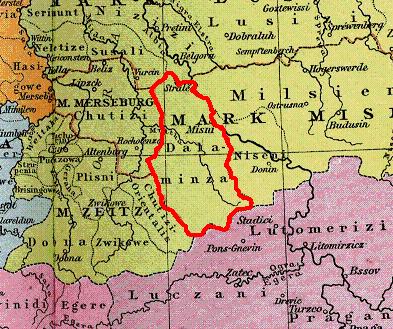Glomatians on:
[Wikipedia]
[Google]
[Amazon]
 The Glomacze, also Golomacze or Dolomici ( pl, Głomacze or ''Gołomacze'', german: Daleminzier) - were
The Glomacze, also Golomacze or Dolomici ( pl, Głomacze or ''Gołomacze'', german: Daleminzier) - were
Polabian Slavs
Polabian Slavs ( dsb, Połobske słowjany, pl, Słowianie połabscy, cz, Polabští slované) is a collective term applied to a number of Lechitic ( West Slavic) tribes who lived scattered along the Elbe river in what is today eastern German ...
inhabiting areas in the middle Elbe
The Elbe (; cs, Labe ; nds, Ilv or ''Elv''; Upper and dsb, Łobjo) is one of the major rivers of Central Europe. It rises in the Giant Mountains of the northern Czech Republic before traversing much of Bohemia (western half of the Czech Repu ...
(''Łaba'') valley. Other West Slavic tribes such as the Milceni
The Milceni or Milzeni ( cs, Milčané; german: Milzener; pl, Milczanie) were a West Slavic tribe, who settled in the present-day Upper Lusatia region. They were first mentioned in the middle of the 9th century AD by the Bavarian Geographer, who ...
settled east of them. About 850 the Bavarian Geographer The epithet "Bavarian Geographer" ( la, Geographus Bavarus) is the conventional name for the anonymous author of a short Latin medieval text containing a list of the tribes in Central-Eastern Europe, headed ().
The name "Bavarian Geographer" was ...
located a ''Talaminzi (Dala-Daleminzi)'' settlement area east of the Sorbs
Sorbs ( hsb, Serbja, dsb, Serby, german: Sorben; also known as Lusatians, Lusatian Serbs and Wends) are a indigenous West Slavic ethnic group predominantly inhabiting the parts of Lusatia located in the German states of Saxony and Brandenbu ...
. According to later chronicler Thietmar of Merseburg
Thietmar (also Dietmar or Dithmar; 25 July 9751 December 1018), Prince-Bishop of Merseburg from 1009 until his death, was an important chronicler recording the reigns of German kings and Holy Roman Emperors of the Ottonian (Saxon) dynasty. Two ...
, the people called themselves Glomacze after a central cult site, a now dry lake near the present-day town of Lommatzsch
Lommatzsch (; hsb, Hłomač) is a municipality located in the district of Meißen in the Free State of Saxony, Germany.
Geography
Lommatzsch lies amidst the so-called ''Lommatzscher Pflege'', an area of land featuring high quality loessic so ...
.
The first known account about the Glomacze is from 805 when they were raided by the troops of Frankish
Frankish may refer to:
* Franks, a Germanic tribe and their culture
** Frankish language or its modern descendants, Franconian languages
* Francia, a post-Roman state in France and Germany
* East Francia, the successor state to Francia in Germany ...
king Charles the Younger
Charles the Younger or Charles of Ingelheim (c. 772 – 4 December 811) was a member of the Carolingian dynasty, the second son of Charlemagne and the first by his second wife, Hildegard of Swabia and brother of Louis the Pious and Pepin Carloman ...
on his way to Bohemia
Bohemia ( ; cs, Čechy ; ; hsb, Čěska; szl, Czechy) is the westernmost and largest historical region of the Czech Republic. Bohemia can also refer to a wider area consisting of the historical Lands of the Bohemian Crown ruled by the Bohem ...
. The actual conquest of the tribe started in early 929 by the German king Henry the Fowler
Henry the Fowler (german: Heinrich der Vogler or '; la, Henricus Auceps) (c. 876 – 2 July 936) was the Duke of Saxony from 912 and the King of East Francia from 919 until his death in 936. As the first non-Frankish king of East Francia, he ...
who, as Widukind of Corvey
Widukind of Corvey (c. 925after 973) was a medieval Saxon chronicler. His three-volume ''Res gestae Saxonicae sive annalium libri tres'' is an important chronicle of 10th-century Germany during the rule of the Ottonian dynasty.
Life
In view of ...
reported, seized and destroyed their main castle called Gana at the siege of Gana
The siege of Gana was a twenty-day siege by a German army led by King Henry the Fowler against a Slavic Glomacze fortification, that took place in early 929 at the fort of Gana, named so after the nearby Jahna river.
In early 929, King Henry led ...
(probably located near present-day Stauchitz
Stauchitz is a municipality in the district of Meißen, in Saxony, Germany
Germany,, officially the Federal Republic of Germany, is a country in Central Europe. It is the second most populous country in Europe after Russia, and the ...
), exterminated the defenders and had a fortress erected on the hill of Meissen
Meissen (in German orthography: ''Meißen'', ) is a town of approximately 30,000 about northwest of Dresden on both banks of the Elbe river in the Free State of Saxony, in eastern Germany. Meissen is the home of Meissen porcelain, the Albrecht ...
(''Mišno''). Their settlement area was incorporated into the large Saxon Marca Geronis
The ''Marca Geronis'' (march of Gero) was a vast super-march in the middle of the tenth century. It was created probably for Thietmar (in the 920s) and passed to his two sons consecutively: Siegfried and Gero. On Gero's death in 965 it was divide ...
and in 965 became part of the Margraviate of Meissen
The Margravate of Meissen (german: Markgrafschaft Meißen) was a medieval principality in the area of the modern German state of Saxony. It originally was a frontier march
In medieval Europe, a march or mark was, in broad terms, any kind of bor ...
.
Citations
Bibliography
* {{Slavic ethnic groups (VII-XII century) Polabian Slavs 9th century in East Francia 10th century in East Francia